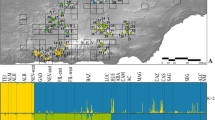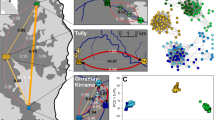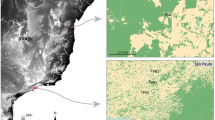Abstract
Amphibians are more threatened than any other vertebrate group, with 41 % of species classified as threatened. The causes of most declines are not well understood, though many declines have been linked to disease. Additionally, amphibians are physiologically constrained to moist habitats and considered poor dispersers; thus, they may suffer genetic consequences of population isolation. To understand threats to the persistence of boreal toads (Bufo boreas) in Glacier National Park, USA, we genotyped 551 individuals at 11 microsatellite loci and used Bayesian clustering methods to describe population genetic structure and identify barriers to gene flow. We found evidence of two primary genetic groups that differed substantially in elevation and two secondary groups within the high elevation group. There was also evidence of further substructure within the southern high elevation group, suggesting mountain ridges are barriers to gene flow at local scales. Overall, genetic variation was high, but allelic richness declined with increasing elevation, reflecting greater isolation or smaller effective population sizes of high altitude populations. We tested for Batrachochytrium dendrobatidis (Bd), the fungal pathogen which causes chytridiomycosis, and we found that 35 of 199 toads were positive for Bd. Unexpectedly, more heterozygous individuals were more likely to be infected. This suggests that dispersal facilitates the spread of disease because heterozygosity may be highest where dispersal and gene flow are greatest.




Similar content being viewed by others
References
Adams S, Schmetterling D, Young M (2005) Instream movement by boreal toads (Bufo boreas boreas). Herpetol Rev 36:27–33
Allendorf FW (1986) Genetic drift and the loss of alleles versus heterozygosity. Zoo Biol 5:181–190
Andreasen V, Christiansen FB (1989) Persistence of an infectious disease in a subdivided population. Math Biosci 96:239–253
Annis SL, Dastoor FP, Ziel H et al (2004) A DNA-based assay identifies Batrachochytrium dendrobatidis in amphibians. J Wildl Dis 40:420–428
Bartelt PE, Peterson CR, Klaver RW (2004) Sexual differences in the post-breeding movements and habitats selected by western toads (Bufo boreas) in southeastern Idaho. Herpetologica 60:455–467
Berger L, Speare R, Daszak P et al (1998) Chytridiomycosis causes amphibian mortality associated with population declines in the rain forests of Australia and Central America. Proc Natl Acad Sci USA 95:9031–9036
Blaustein AR, Wake DB, Sousa WP (1994) Amphibian declines: judging stability, persistence, and susceptibility of populations to local and global extinctions. Conserv Biol 8:60–71
Bonin A, Taberlet P, Miaud C, Pompanon F (2006) Explorative genome scan to detect candidate loci for adaptation along a gradient of altitude in the common frog (Rana temporaria). Mol Biol Evol 23:773–783
Brown JH, Kodric-Brown A (1977) Turnover rates in insular biogeography: effect of immigration on extinction. Ecology 58:445–449
Clarke BC (1979) The evolution of genetic diversity. Proc R Soc Lond B 205:453–474
Coltman DW, Pilkington JG, Smith JA, Pemberton JM (1999) Parasite-mediated selection against inbred Soay sheep in a free-living, island population. Evolution 53:1259–1267
Corn PS, Hossack BR, Muths E et al (2005) Status of amphibians on the Continental Divide: surveys on a transect from Montana to Colorado, USA. Alytes 22:85–94
Coulon A (2009) Genhet: an easy-to-use R function to estimate individual heterozygosity. Mol Ecol Resour 10:167–169
Crawford AJ, Lips KR, Bermingham E (2010) Epidemic disease decimates amphibian abundance, species diversity, and evolutionary history in the highlands of central Panama. Proc Natl Acad Sci USA 107:13777–13782
Daugherty CH, Sheldon AL (1982) Age-specific movement patterns of the frog Ascaphus truei. Herpetologica 38:468–474
Duellman WE, Trueb L (1994) The biology of amphibians. Johns Hopkins University Press, Baltimore
Epps CW, Palsbøll PJ, Wehausen JD et al (2005) Highways block gene flow and cause a rapid decline in genetic diversity of desert bighorn sheep. Ecol Lett 8:1029–1038
Evanno G, Regnaut S, Goudet J (2005) Detecting the number of clusters of individuals using the software structure: a simulation study. Mol Ecol 14:2611–2620
Fisher MC, Garner TWJ, Walker SF (2009) Global emergence of Batrachochytrium dendrobatidis and amphibian chytridiomycosis in space, time, and host. Annu Rev Microbiol 63:291–310
Frankham R (1996) Relationship of genetic variation to population size in wildlife. Conserv Biol 10:1500–1508
Frankham R (2005) Genetics and extinction. Biol Conserv 126:131–140
Funk WC, Blouin MS, Corn PS et al (2005) Population structure of Columbia spotted frogs (Rana luteiventris) is strongly affected by the landscape. Mol Ecol 14:483–496
Giordano AR, Ridenhour BJ, Storfer A (2007) The influence of altitude and topography on genetic structure in the long-toed salamander (Ambystoma macrodactulym). Mol Ecol 16:1625–1637
Goebel AM, Ranker TA, Corn PS, Olmstead RG (2009) Mitochondrial DNA evolution in the Anaxyrus boreas species group. Mol Phylogenet Evol 50:209–225
Goudet J (2001) FSTAT, a program to estimate and test gene diversities and fixation indices (version 2.9.3). http://www.unil.ch/izea/softwares/fstat.html
Guillot G, Estoup A, Mortier F, Cosson JF (2005a) A spatial statistical model for landscape genetics. Genetics 170:1261–1280
Guillot G, Mortier F, Estoup A (2005b) Geneland: a computer package for landscape genetics. Mol Ecol Notes 5:712–715
Guo SW, Thompson EA (1992) A Monte Carlo method for combined segregation and linkage analysis. Am J Hum Genet 51:1111
Hammerson GA, Santos-Barrera G, Muths E (2004) Anaxyrus boreas. IUCN red list of threatened species, version 2012.2. http://www.redlist.org
Harcourt AH, Coppeto SA, Parks SA (2002) Rarity, specialization and extinction in primates. J Biogeogr 29:445–456
Harris RT (1975) Seasonal activity and microhabitat utilization in Hyla cadaverina (Anura: Hylidae). Herpetologica 31:236–239
Hedrick PW, Kim TJ, Parker KM (2001) Parasite resistance and genetic variation in the endangered Gila topminnow. Anim Conserv 4:103–109
Hess G (1996) Disease in metapopulation models: implications for conservation. Ecology 77:1617–1632
Hethcote HW (1976) Qualitative analyses of communicable disease models. Math Biosci 28:335–356
Hoffmann M, Hilton-Taylor C, Angulo A et al (2010) The impact of conservation on the status of the world’s vertebrates. Science 330:1503–1509
Hossack BR, Lowe WH, Corn PS (2013a) Rapid increases and time-lagged declines in amphibian occupancy after wildfire. Conserv Biol 27:219–228
Hossack BR, Lowe WH, Ware JL, Corn PS (2013b) Disease in a dynamic landscape: host behavior and wildfire reduce amphibian chytrid infection. Biol Conserv 157:293–299
Kilpatrick AM, Briggs CJ, Daszak P (2010) The ecology and impact of chytridiomycosis: an emerging disease of amphibians. Trends Ecol Evol 25:109–118
Kimura M, Maruyama T, Crow JF (1963) The mutation load in small populations. Genetics 48:1303–1312
Kleeberger SR, Werner JK (1982) Home range and homing behavior of Plethodon cinereus in northern Michigan. Copeia 1982:409–415
Leung LR, Qian Y, Bian X et al (2004) Mid-century ensemble regional climate change scenarios for the western United States. Clim Change 62:75–113
Lips KR, Brem F, Brenes R et al (2006) Emerging infectious disease and the loss of biodiversity in a neotropical amphibian community. Proc Natl Acad Sci USA 103:3165–3170
Lougheed SC, Gascon C, Jones DA et al (1999) Ridges and rivers: a test of competing hypotheses of Amazonian diversification using a dart-poison frog (Epipedobates femoralis). Proc R Soc Lond B 266:1829–1835
Lowe WH, Allendorf FW (2010) What can genetics tell us about population connectivity? Mol Ecol 19:3038–3051
Lowe WH, Mcpeek MA, Likens GE, Cosentino BJ (2008) Linking movement behaviour to dispersal and divergence in plethodontid salamanders. Mol Ecol 17:4459–4469
Luikart G, Pilgrim K, Visty J et al (2008) Candidate gene microsatellite variation is associated with parasitism in wild bighorn sheep. Biol Lett 4:228–231
Luquet E, David P, Lena J-P et al (2011) Heterozygosity–fitness correlations among wild populations of European tree frog (Hyla arborea) detect fixation load. Mol Ecol 20:1877–1887
Manier MK, Arnold SJ (2006) Ecological correlates of population genetic structure: a comparative approach using a vertebrate metacommunity. Proc R Soc B 273:3001–3009
Mantel N (1967) The detection of disease clustering and a generalized regression approach. Cancer Res 27:209–220
McCauley DE (1991) Genetic consequences of local population extinction and recolonization. Trends Ecol Evol 6:5–8
McRae BH, Beier P, Dewald LE et al (2005) Habitat barriers limit gene flow and illuminate historical events in a wide-ranging carnivore, the American puma. Mol Ecol 14:1965–1977
Meagher S (1999) Genetic diversity and Capillaria hepatica (Nematoda) prevalence in Michigan deer mouse populations. Evolution 53:1318–1324
Moore JA, Tallmon DA, Nielsen J, Pyare S (2011) Effects of the landscape on boreal toad gene flow: does the pattern–process relationship hold true across distinct landscapes at the northern range margin? Mol Ecol 20:4858–4869
Mote PW (2006) Climate-driven variability and trends in mountain snowpack in western North America. J Clim 19:6209–6220
Murphy MA, Evans JS, Storfer A (2010) Quantifying Bufo boreas connectivity in Yellowstone National Park with landscape genetics. Ecology 91:252–261
Muths E (2003) Home range and movements of boreal toads in undisturbed habitat. Copeia 2003:160–165
Muths E, Stephen Corn P, Pessier AP, Earl Green D (2003) Evidence for disease-related amphibian decline in Colorado. Biol Conserv 110:357–365
Newman D, Pilson D (1997) Increased probability of extinction due to decreased genetic effective population size: experimental populations of Clarkia pulchella. Evolution 51:354–362
Newman RA, Squire T (2001) Microsatellite variation and fine-scale population structure in the wood frog (Rana sylvatica). Mol Ecol 10:1087–1100
Nichols D, Lamirande E, Pessier A, Longcore J (2001) Experimental transmission of cutaneous chytridiomycosis in dendrobatid frogs. J Wildl Dis 37:1–11
Peakall R, Smouse PE (2005) GenAlEx 6: genetic analysis in Excel. Population genetic software for teaching and research. Mol Ecol Notes 6:288–295
Pérez-Espona S, Pérez-Barbería FJ, Mcleod JE et al (2008) Landscape features affect gene flow of Scottish Highland red deer (Cervus elaphus). Mol Ecol 17:981–996
Pidancier N, Miquel C, Miaud C (2003) Buccal swabs as a non-destructive tissue sampling method for DNA analysis in amphibians. Herpetol J 13:175–178
Pilliod DS, Muths E, Scherer RD et al (2010) Effects of amphibian chytrid fungus on individual survival probability in wild boreal toads. Conserv Biol 24:1259–1267
Post WM, DeAngelis DL, Travis CC (1983) Endemic disease in environments with spatially heterogeneous host populations. Math Biosci 63:289–302
Pritchard JK, Stephens M, Donnelly P (2000) Inference of population structure using multilocus genotype data. Genetics 155:945–959
Purvis A, Jones KE, Mace GM (2000) Extinction. Bioessays 22:1123–1133
R Development Core Team (2011) R: A language and environment for statistical computing. R Foundation for Statistical Computing, Vienna
Raymond M, Rousset F (1995) GENEPOP (Version 1.2): population genetics software for exact tests and ecumenicism. J Hered 86:248–249
Roelke ME, Martenson JS, O’Brien SJ (1993) The consequences of demographic reduction and genetic depletion in the endangered Florida panther. Curr Biol 3:340–350
Ron SR (2005) Predicting the distribution of the amphibian pathogen Batrachochytrium dendrobatidis in the New World. Biotropica 37:209–221
Rothermel BB, Semlitsch RD (2002) An experimental investigation of landscape resistance of forest versus old-field habitats to emigrating juvenile amphibians. Conserv Biol 16:1324–1332
Saccheri I, Kuussaari M, Kankare M et al (1998) Inbreeding and extinction in a butterfly metapopulation. Nature 392:491–494
Savage AE, Zamudio KR (2011) MHC genotypes associate with resistance to a frog-killing fungus. Proc Natl Acad Sci USA 108:16705–16710
Schwartz MK, McKelvey KS (2009) Why sampling scheme matters: the effect of sampling scheme on landscape genetic results. Conserv Genet 10:441–452
Semlitsch RD (1981) Terrestrial activity and summer home range of the mole salamander (Ambystoma talpoideum). Can J Zool 59:315–322
Semlitsch RD, Todd BD, Blomquist SM et al (2009) Effects of timber harvest on amphibian populations: understanding mechanisms from forest experiments. Bioscience 59:853–862
Simandle ET, Peacock MM, Zirelli L, Tracy CR (2005) Sixteen microsatellite loci for the Bufo boreas group. Mol Ecol Notes 6:116–119
Skerratt L, Berger L, Speare R et al (2007) Spread of chytridiomycosis has caused the rapid global decline and extinction of frogs. EcoHealth 4:125–134
Spear SF, Peterson CR, Matocq MD, Storfer A (2005) Landscape genetics of the blotched tiger salamander (Ambystoma tigrinum melanostictum). Mol Ecol 14:2553–2564
Spielman D, Brook BW, Briscoe DA, Frankham R (2004) Does inbreeding and loss of genetic diversity decrease disease resistance? Conserv Genet 5:439–448
Stuart SN, Chanson JS, Cox NA et al (2004) Status and trends of amphibian declines and extinctions worldwide. Science 306:1783–1786
Switzer JF, Johnson R, Lubinski BA, King TL (2009) Genetic structure in the Bufo boreas species group (Anura, Bufonidae): an evaluation of the Southern Rocky Mountain population. United States Fish and Wildlife Service, Mountain-Prairie region
Tallmon DA, Funk WC, Dunlap WW, Allendorf FW (2000) Genetic differentiation among long-toed salamander (Ambystoma macrodactylum) populations. Copeia 2000:27–35
Tracy CR, Dole JW (1969) Orientation of displaced California toads, Bufo boreas, to their breeding sites. Copeia 1969:693–700
Waples RS, Gaggiotti O (2006) INVITED REVIEW: What is a population? An empirical evaluation of some genetic methods for identifying the number of gene pools and their degree of connectivity. Mol Ecol 15:1419–1439
Weir BS, Cockerham CC (1984) Estimating F-statistics for the analysis of population structure. Evolution 38:1358–1370
Wright S (1931) Evolution in Mendelian populations. Genetics 16:97–159
Yang W, Qi Y, Bi K, Fu J (2012) Toward understanding the genetic basis of adaptation to high-elevation life in poikilothermic species: a comparative transcriptomic analysis of two ranid frogs, Rana chensinensis and R. kukunoris. BMC Genom 13:588
Acknowledgments
We thank Tom Brekke, Kris Crandell, Sara Dykeman, Nate Muhn, Paul Scarr, and numerous field technicians who collected samples between 2008 and 2011. Sally Painter and Steve Amish provided assistance with lab work and genotyping. Marty Kardos provided assistance with randomization tests, and Eric Fuchs provided statistical advice. This manuscript was improved with comments from Mike Schwartz. This research was performed under University of Montana IACUC permit 022-09WLDBS-051209. Partial funding was provided by the Jerry O’Neal student fellowship and the U.S. Geological Survey Amphibian Research and Monitoring Initiative (ARMI). This manuscript is ARMI product number 499. Use of trade, product, or firm names does not imply endorsement by the U.S. Government.
Author information
Authors and Affiliations
Corresponding author
Electronic supplementary material
Below is the link to the electronic supplementary material.
Rights and permissions
About this article
Cite this article
Addis, B.R., Lowe, W.H., Hossack, B.R. et al. Population genetic structure and disease in montane boreal toads: more heterozygous individuals are more likely to be infected with amphibian chytrid. Conserv Genet 16, 833–844 (2015). https://doi.org/10.1007/s10592-015-0704-6
Received:
Accepted:
Published:
Issue Date:
DOI: https://doi.org/10.1007/s10592-015-0704-6




